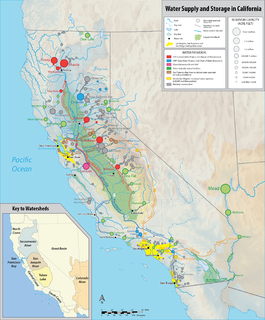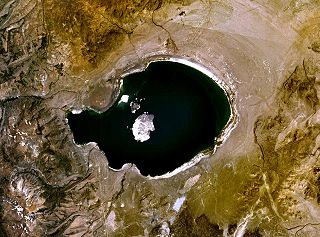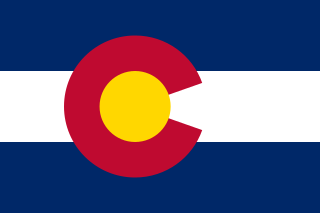
Water resources law is the field of law dealing with the ownership, control, and use of water as a resource. It is most closely related to property law, and is older than and distinct from laws governing water quality.
In the United States, state law refers to the law of each separate U.S. state.
Riparian water rights is a system for allocating water among those who possess land along its path. It has its origins in English common law. Riparian water rights exist in many jurisdictions with a common law heritage, such as Canada, Australia, and states in the eastern United States.
Prior appropriation water rights is the legal doctrine that the first person to take a quantity of water from a water source for "beneficial use" has the right to continue to use that quantity of water for that purpose.
Water right in water law refers to the right of a user to use water from a water source, e.g., a river, stream, pond or source of groundwater. In areas with plentiful water and few users, such systems are generally not complicated or contentious. In other areas, especially arid areas where irrigation is practiced, such systems are often the source of conflict, both legal and physical. Some systems treat surface water and ground water in the same manner, while others use different principles for each.
Colorado River Water Conservation District v. United States, 424 U.S. 800 (1976), was a case in which the Supreme Court of the United States created a new doctrine of abstention, to prevent duplicative litigation between state and federal courts.
Wisconsin v. Illinois, 278 U.S. 367 (1929), also referred to as the Chicago Sanitary District Case, is an opinion of the Supreme Court of the United States which held that the equitable power of the United States can be used to impose positive action on one state in a situation in which nonaction would result in damage to the interests of other states. Pursuant to Article Three of the United States Constitution, the case was heard under the Supreme Court's original jurisdiction because it involved a controversy between two states, Illinois and Wisconsin. Chief Justice William Howard Taft wrote the opinion for a unanimous Court.
Kansas v. Colorado is a longstanding litigation before the Supreme Court of the United States between two states of the United States, Kansas and Colorado. The Court has rendered numerous opinions in this case:
Arizona v. California is a set of United States Supreme Court cases, all dealing with disputes over water distribution from the Colorado River between the states of Arizona and California. It also covers the amount of water that the State of Nevada receives from the river as well.
St. Louis v. Myers, 113 U.S. 566 (1885), was a motion to dismiss for want of a federal question to give jurisdiction regarding Acts that admitted Missouri into the Union while leaving the rights of riparian owners on the Mississippi River to be settled according to the principles of state law and relinquishing to the City of St. Louis the rights of the United States in wharves and thoroughfares, which did not authorize the city to impair the rights of other riparian proprietors by extending streets into the river.

California's interconnected water system serves over 30 million people and irrigates over 5,680,000 acres (2,300,000 ha) of farmland. As the world's largest, most productive, and most controversial water system, it manages over 40 million acre feet (49 km3) of water per year.
Winters v. United States, 207 U.S. 564 (1908), was a United States Supreme Court case clarifying water rights of American Indian reservations. This doctrine was meant to clearly define the water rights of American Indians in cases where the rights were not clear. The case was first argued on October 24, 1907 and a decision was reached January 6, 1908. This case set the standards for the United States government to acknowledge the vitality of American Indian water rights, and how rights to the water relate to the continuing survival and self-sufficiency of American Indian people.
Water law in the United States refers to the Water resources law laws regulating water as a resource in the United States. Beyond issues common to all jurisdictions attempting to regulate water's uses, water law in the United States must contend with:

Water in Colorado is of significant importance, as the American state of Colorado is the 7th-driest state in America. As result, water rights generate conflict, with many water lawyers in the state.
The McCarran Amendment, 43 U.S.C. § 666 (1952) is a federal law enacted by the United States Congress in 1952 which waives the United States' sovereign immunity in suits concerning ownership or management of water rights. It amended Chapter 15 of Title 43 of the United States Code. The McCarran Amendment gives others the right to join in such a lawsuit as a defendant. Prior to the Amendment, sovereign immunity kept the United States from being joined in any suits. The Amendment enabled suits concerning federal water rights to be tried in state courts.

National Audubon Society v. Superior Court was a key case in California highlighting the conflict between the public trust doctrine and appropriative water rights. The Public Trust Doctrine is based on the principle that certain resources are too valuable to be privately owned and must remain available for public use. In National Audubon Society v. Superior Court, the court held that the public trust doctrine restricts the amount of water that can be withdrawn from navigable waterways. The basis for the Public Trust Doctrine goes back to Roman law. Under Roman law, the air, the rivers, the sea and the seashore were incapable of private ownership; they were dedicated to the use of the public. In essence, the public trust doctrine establishes the role of the state as having trustee environmental duties owed to the public that are subsequently enforceable by the public. There is judicial recognition of this, dictating that certain rights of the public are key to individual common law rights. Judicial recognition of the public trust doctrine has been established for tidelands and non-navigable waterways, submerged land and the waters above them, and preservation of a public interest.
Colorado Water Trust* (“CWT”) is a non-profit conservation organization based in the state of Colorado. Its mission is to engage in and support voluntary, market-based efforts to restore and protect streamflows using permanent acquisitions of water, leases of water, and physical solutions. CWT is also a resource to Colorado land trusts encountering water issues in connection with their land conservation activities.
Lux v. Haggin, 69 Cal. 255; 10 P. 674; (1886), is a historic case in the conflict between riparian and appropriative water rights. Decided by a vote of four to three in the Supreme Court of California, the ruling held that appropriative rights were secondary to riparian rights.
The original jurisdiction of the Supreme Court of the United States is limited to a small class of cases described in Article III, section 2, of the United States Constitution, and further delineated by statute.








